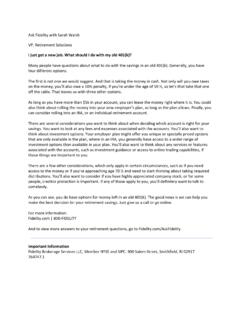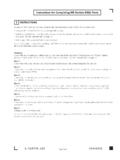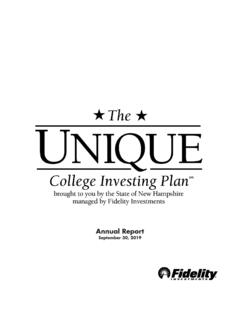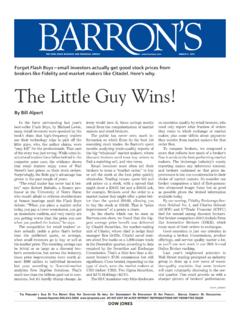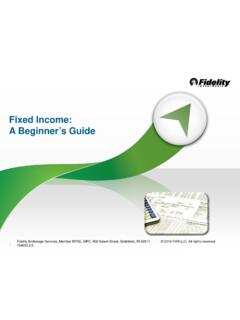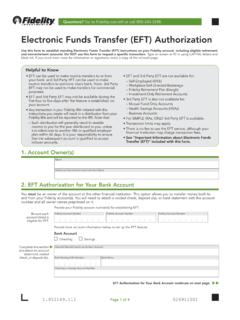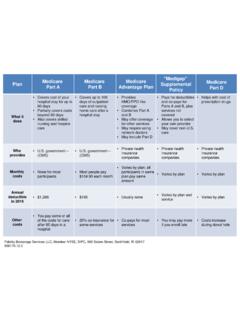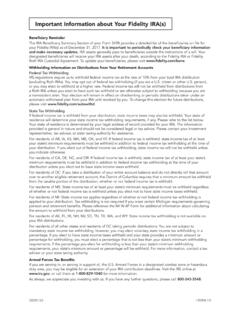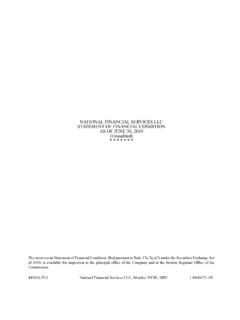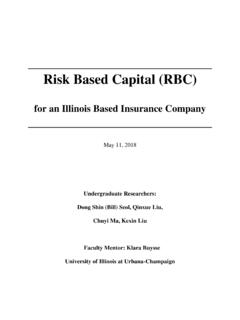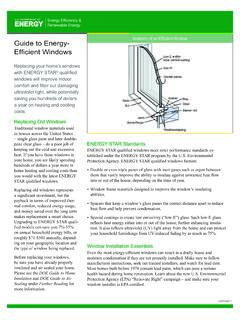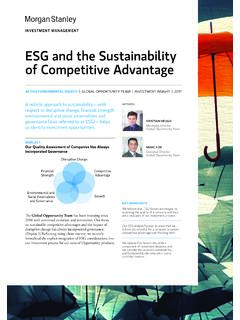Transcription of An Overview of Factor Investing - Fidelity Investments
1 LEADERSHIP SERIESAn Overview of Factor InvestingThe merits of factors as potential building blocks for portfolio constructionDarby Nielson, CFA l Managing Director of Research, Equity and High IncomeFrank Nielsen, CFA l Managing Director of Quantitative Research, Strategic Advisers, Barnes l Quantitative Analyst, Equity and High IncomeKey Takeaways factors such as size, value, momentum, quality, and low volatility are at the core of smart or strategic beta strategies, and are investment characteristics that can enhance portfolios over time. Factor performance tends to be cyclical, but most Factor returns generally are not highly correlated with one another, so investors can benefit from diversification by combining mul-tiple Factor exposures. Factor - based strategies may help investors meet certain investment objectives such as potentially improving returns or reducing risk over the long Investing has received considerable attention recently, primarily because factors are the cornerstones of smart or strategic beta strategies that have become popular among individual and institutional investors.
2 In fact, these strategies had net inflows of nearly $250 billion during the past five But investors actually have been employing Factor - based techniques in some form for decades, seeking the potential enhanced risk-adjusted-return benefits of certain Factor exposures. In this article, we define Factor Investing and review its history, examine five common factors and the theory behind them, show their performance and cyclicality over time, and discuss the potential benefits of Investing in Factor - based strategies. Our goal is to provide a broad Overview of Factor Investing as a framework that incorporates Factor -exposure decision-making into the portfolio construction process. This article is the first in a series on Factor Evolution of Factor Investing 2A brief history of Factor investingBeta is bornThe seeds of Factor Investing were sown in the 1960s, when the capital asset pricing model (CAPM) was first The CAPM posited that every stock has some level of sensitivity to the movement of the broader market measured as beta.
3 This first and most basic Factor model suggested that a single Factor market exposure drives the risk and return of a stock. The CAPM suggested that beyond the market Factor , what are left to explain a stock s returns are idiosyncratic, or company-specific, drivers ( , earnings beats and misses, new product launches, CEO changes, accounting issues, etc.). Beta gets smart In the decades that followed, academics and practitioners discovered other factors and exposures that drive the returns of Stephen Ross introduced an extension of the CAPM called the arbitrage pricing theory (APT) in 1976, suggesting a multifactor approach may be a better model for explaining stock Later research by Eugene Fama and Kenneth French demonstrated that besides the market Factor , the size of a company and its valuation are also important drivers of its stock factors can also be considered anomalies, since they are deviations from the efficient market hypothesis, which suggests it is impossible to consistently outperform the market over time because stock Company-SpecificCompany-SpecificCompany- SpecificMarketMarketMarketSizeSizeStyleV alueMomentumQualityVolatilityCAPM: Stock returns are driven by exposure to the market Factor (beta) and company-specific driversFama and French account for additional factors .
4 Size and styleResearch proves the case for multiple factors as components of stock returns and riskHow can investors gain exposure to factors ? Factor - based investment strategies are founded on the systematic analysis, selection, weighting, and rebalancing of portfolios, in favor of stocks with certain characteristics that have been proven to enhance risk-adjusted returns over time. Most commonly, investors gain exposure to factors using quantitative, actively managed funds or rules- based ETFs designed to track custom Overview OF Factor INVESTINGEXHIBIT 1: Small-Cap Excess ReturnsSmall caps have beaten larger caps over time, even though this leadership can shift over shorter periodsSmall-cap returns shown are yearly returns of the equal-weighted bottom quintile (by market capitalization) of the Russell 1000 Index. All excess returns are relative to the equal-weighted Russell 1000 Index. All Factor portfolios are sector neutral, assume dividend reinvestment, and exclude fees and implementation costs.
5 Avg.: compound average of yearly excess returns. Past performance is no guarantee of future results. Source: FactSet, as of Mar. 31, yield: last 12 months of earnings per share divided by price per share. Book/price ratio: the ratio of a company s reported accumulated profits to its price per share. Returns shown are yearly returns of the equal-weighted top quintile ( based on these two value metrics) of the Russell 1000 Index. Past performance is no guarantee of future results. Source: FactSet, as of Mar. 31, 2016. prices immediately incorporate and reflect all available information. And while some factors can, indeed, generate excess returns over time, other factors explain the risk of stocks but do not necessarily provide a return premium. As an example, many would argue that CAPM beta, almost by definition, does not deliver excess returns over time; it measures only a stock s sensitivity to market movement and may instead be a risk Factor . Therefore, exposure to market beta alone is not a way to outperform.
6 Investors seeking returns in excess of the market may consider exposure to other factors (or betas) that have exhibited long-term outperformance: smart or strategic managers quantitative investors in particular have employed these factors over the years to build and enhance their portfolios. Once the relevant factors that drive return and risk are identified, exposures can be measured on an ongoing basis to ensure a portfolio is best structured to take advantage of these factors . Fundamental investors also use factors widely, either as a means to generate new stock ideas, or to monitor intended or unintended exposures in their key factors The following five factors have been identified by academics and widely adopted by investors over the years as key exposures in a SizeIn pinpointing the first of their two identified factors , Fama and French demonstrated that a return premium exists for Investing in smaller-cap stocks. This could be due to their inherently riskier nature: Smaller companies are typically more volatile and have a higher risk of bankruptcy, and investors expect to be compensated for taking on that additional level of risk.
7 As shown in Exhibit 1, empirical evidence demonstrates that over longer periods of time, small-cap stocks outperform large caps. Exposure to small-cap stocks can be achieved relatively easily by using standard market capitalizations. For most EXHIBIT 2: Excess Returns of Two Value Measures The performance of a value portfolio can vary based on how value is defined3 10%0%10%20%30%40%50%60%19861988199019921 9941996199820002002200420062008201020122 0142015 Yearly Excess Return1986198819901992199419961998200020 022004200620082010201220142015 20% 10%0%10%20%30%40%Yearly Excess ReturnBook/Price RatioEarnings Book/Price Avg. Earnings , holding a small-cap fund or ETF, for example, is a straightforward and relatively efficient way to harvest the small-cap premium. However, the inherently riskier nature of Investing in smaller companies is important to bear in ValueThe second Factor introduced in the Fama French model is value, suggesting that inexpensive stocks should outperform more expensive ones.
8 Research on the field of value Investing stretches back many decades. In 1949, Benjamin Graham urged investors to buy stocks at a discount to their intrinsic He argued that expensive stocks with lofty expectations leave little room for error, while cheaper stocks that can beat expectations may afford investors more upside. (For further details about the potential benefits of value Investing , see Fidelity Leadership Series article, Value Investing : Out of Favor, but Always in Style, Jun. 2016.) With this in mind, one view is that value Investing works because stocks follow earnings over time. Investors tend to be overly optimistic about expensive, high-growth stocks and overly pessimistic about cheap, slower-growth stocks. When cheap stocks report higher-than-expected earnings (even versus low expectations), they can outperform as a result of the market s improved optimism in their earnings potential. Empirical results also seem to indicate that value Investing can generate excess returns over time.
9 Fama and French demonstrated that stocks with high book-to-price ratios outperformed stocks with lower ratios. Many commonly used indexes still place a heavy emphasis on that definition, and exposure to that particular valuation Factor is easy to gain with available products. Yet there are many different ways to define value. For example, investors may examine earnings, sales, or cash flows to judge whether a stock appears inexpensive, and performance can vary based on which metric is used. Exhibit 2 shows the performance differential between two common measures of value: book-to-price ratio and earnings yield (earnings-to-price ratio). In fact, a single- Factor definition of value may expose investors to greater volatility and larger declines, and a multifactor approach to finding value stocks is typically preferred due to its diversification benefits, which tend EXHIBIT 3: Excess Returns of Value Stocks Inexpensive stocks have outperformed the broader market over the long termEXHIBIT 4: Excess Returns of Momentum Portfolios Due to common investor behaviors, momentum Investing has led to outperformance over timeValue composite is a combined average ranking of stocks in the equal- weighted top quintile (by book/price ratio) and stocks in the equal-weighted top quintile (by earnings yield) of the Russell 1000 Index.
10 Returns shown are yearly returns of this value composite. Past performance is no guarantee of future results. Source: FactSet, as of Mar. 31, 2016. Momentum returns shown are yearly returns of the equal-weighted top quintile (as measured by trailing 12-month returns) of the Russell 1000 Index. Past performance is no guarantee of future results. Source: FactSet, as of Mar. 31, 2016. 10%0% 5%5%10%15%20%25%30%35%198619881990199219 9419961998200020022004200620082010201220 142015 Yearly Excess Return 40% 30% 20% 10%0%10%20%30%Yearly Excess Overview OF Factor INVESTING5to lead to higher returns over time. Exhibit 3 shows that a stock portfolio created using a composite of high book-to-price ratio and high earnings yield outpaced the broader market by on average each year, beating both independent underlying metrics. 3. MomentumThe concept of momentum Investing is similar in spirit to what technical analysts have been doing for decades, namely, examining price trends to forecast future returns.
